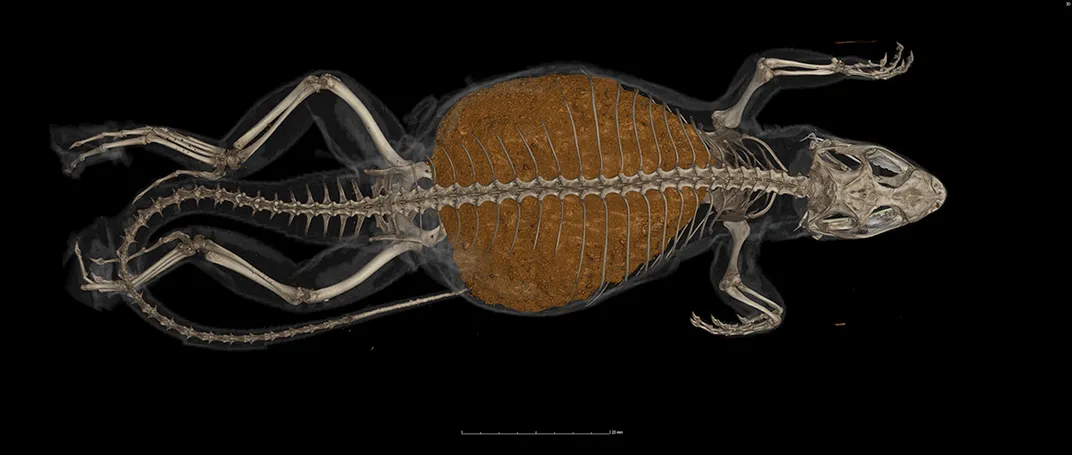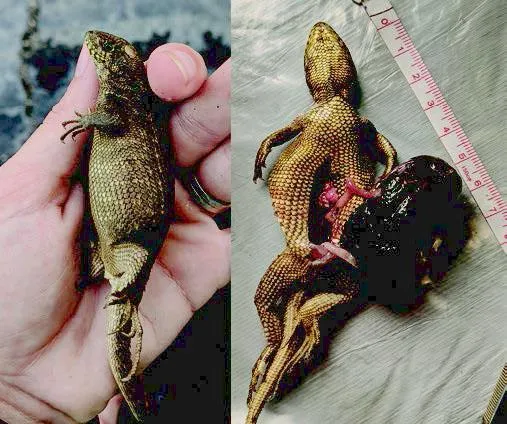Super-Constipated Florida Lizard Breaks Records With Gargantuan Poop
An unfortunate diet of pizza grease and sand clogged her innards, amassing a giant and unpassable lump of feces in her gut
/https://tf-cmsv2-smithsonianmag-media.s3.amazonaws.com/filer/33/f5/33f5d4e6-1422-4cce-ab27-f56eb2843892/side_view_impacted_hm-resize.jpg)
When Natalie Claunch and her colleagues plucked the portly northern curly-tailed lizard (Leiocephalus carinatus) from the site of a beach-side pizza shop in Florida, she suspected she knew the reason behind the reptile’s rotundness. The tubby creature, whose two-inch-long midsection was swollen to the size of a golf ball, was a female, and probably pregnant, the University of Florida herpetologist mused.
But when Claunch and her colleagues began to poke around the animal’s abdomen, they didn’t find any evidence of eggs. Instead, “it just felt like it was full of Silly Putty,” Claunch says in a statement.
The lizard lady’s innards weren’t full of burgeoning babies, the team soon realized. They were instead bursting with poop—22 grams of it in total, enough to account for a third of the poor creature’s entire body volume, and 80 percent of its total weight. The tremendous turd, which had gotten lodged in the very constipated lizard’s gastrointestinal tract, now holds the record for the largest mass of digested food matter ever discovered in a living animal, Claunch’s team reports in a recent note in the journal Herpetological Review.

Everybody poops, of course. But bowel movements aren’t always regular, and the researchers suspect this unlucky lizard fell into this precarious situation after gorging herself on refuse from the Cocoa Beach pizza shop where she was found. Her regular intake of grease, mixed in with accidental gulps of sand and the more typically reptilian fare of insects and other lizards, had seeded a stubborn knot of feces that refused to budge from her body, reports Nina Pullano for Inverse.
In truth, the researchers’ find had some poop precedence. Twice before, Claunch’s team had happened upon curly-tailed lizards teeming with turds that comprised more than 30 percent of their body weight. So when the researchers failed to find evidence of eggs, they stuck the reptile in a CT scanner that revealed that poop had literally turned things pear-shaped.
“I was blown away by how little room there was left for all the other organs,” Florida Museum researcher Edward Stanely says in the statement. “It has only a tiny space left over in its ribcage for the heart, lungs and liver. It must have been a very uncomfortable situation for the poor lizard.”

Northern curly-tailed lizards are native to the Bahamas, the Cayman Islands and Cuba, but were intentionally introduced to Florida in the early 1940s to combat sugar cane pests. Now the invasive, omnivorous reptiles will nosh on just about anything, laying waste to everything from bugs to bits of human refuse. “They’re like sparrows or gulls at a fry stand, without the chirping or swooping,” Claunch says in the statement.
But this dietary flexibility is a double-edged sword: Curly-tailed lizards aren’t picky enough to pass over grub that can clog their guts.
Because they aren’t native to Florida, curly-tailed lizards captured for research can’t be released back into the wild. The lizard, whose gut was blocked by the deuce she couldn’t drop, also appeared to be starving. To better understand their subject’s condition, the researchers humanely euthanized her, then took more precise measurements of the fecal lump.
Though this plucky little creature is no longer with us, she will live on in the scientific literature. She may not be the reigning constipation champion forever—but her title will certainly be tough to take, according to Claunch. “We are unaware of any records from wild or captive animals that approach our finding,” she tells Inverse. “We hope for the sake of the individual animals that there are not any out there!”
/https://tf-cmsv2-smithsonianmag-media.s3.amazonaws.com/accounts/headshot/10172852_10152012979290896_320129237_n.jpg)
/https://tf-cmsv2-smithsonianmag-media.s3.amazonaws.com/accounts/headshot/10172852_10152012979290896_320129237_n.jpg)